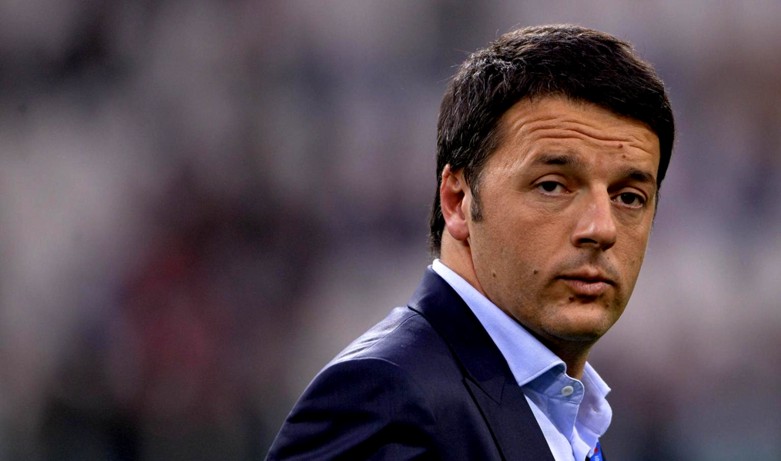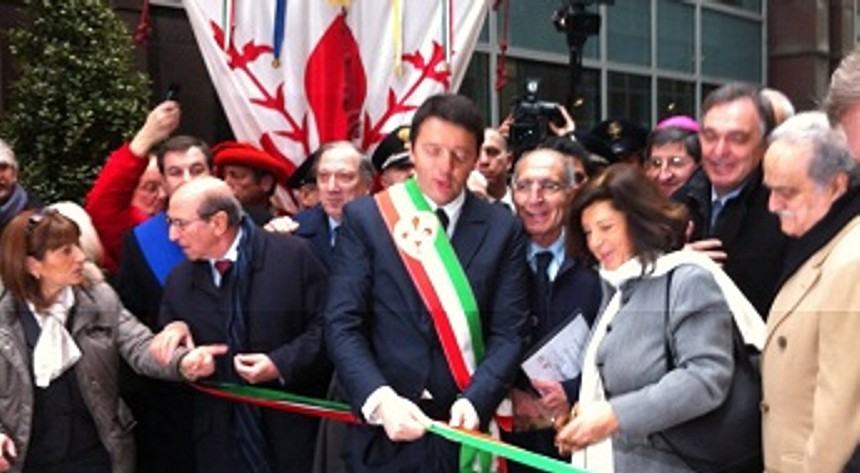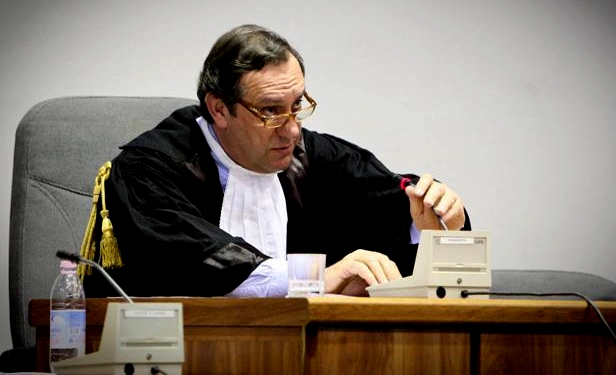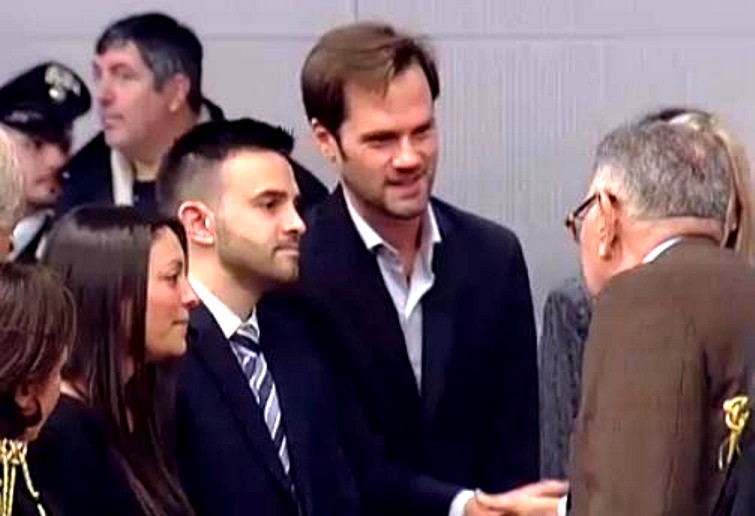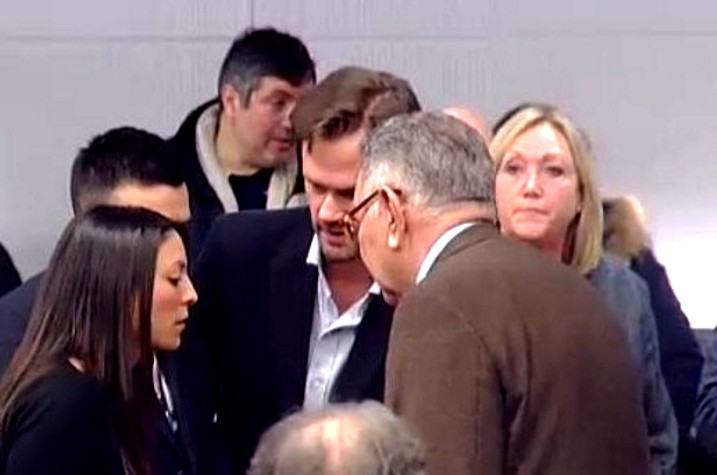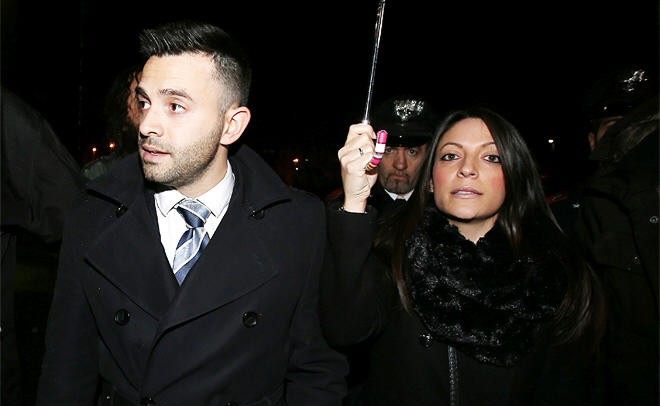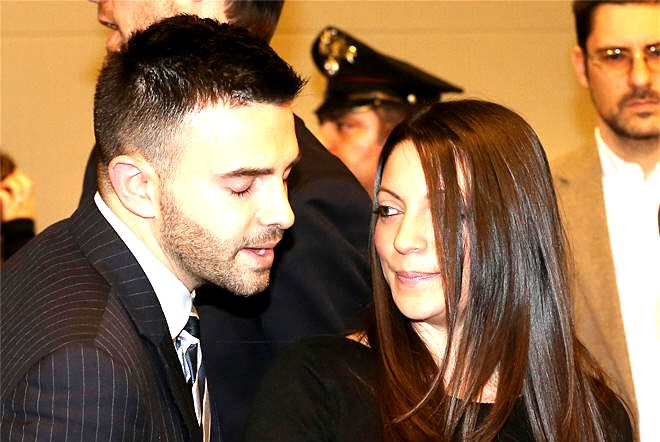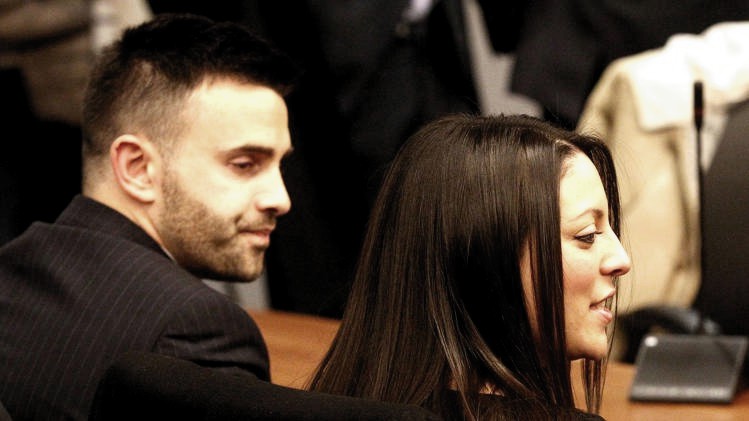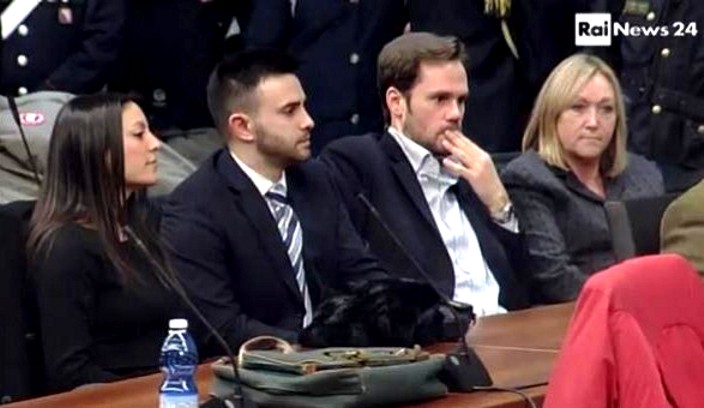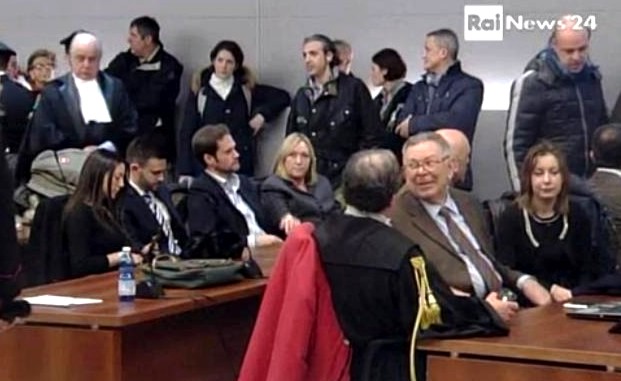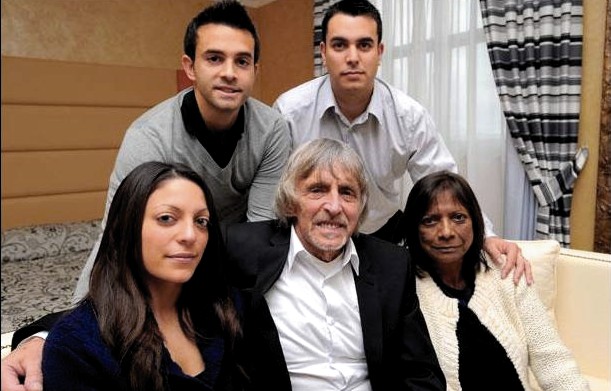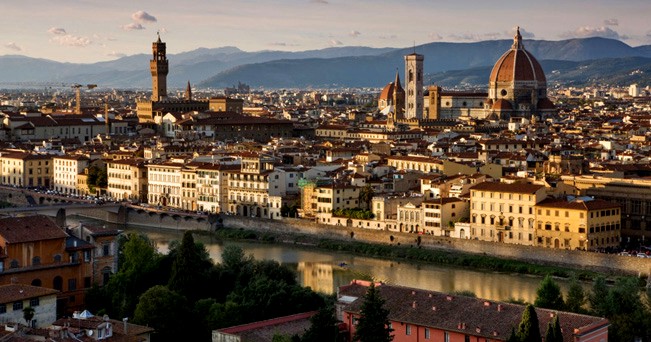
Category: Appeals 2009-2015
Friday, February 28, 2014
What We Might Read Into Sollecito Lawyer Giulia Bongiornos Final Arguments To The Appeal Judges
Posted by Machiavelli
Under the table & over the top
The picture of a serene-looking Giulia Bongiorno waving a couple of knives in court on 9 January may be visual inspiration to this reflection about what we can understand from the structure and content of her closing arguments.
A very peculiar feature of her arguments was the desperate opening, suggesting to put the investigation ““ and the whole justice proceedings ““ on trial.
The introductive topic of her speech is a quote from a book by Alessandro Satta, a narrative description of the riotous irruption of the mob inside the Revolutionary Tribunal hearing room on Sep. 2. 1792, the defendants are the some of the King’s Swiss guards.
The passage by Satta describes the “horrendous” vision of a hord of sanculots slowly gathering outside the court, Bongiorno compares that to the angry mob in Perugia after the first appeal verdict.
But if you read the same text by Satta a little further, a few lines beyond the snippet Bongiorno was reading, the narration goes on describing how sanculots manage to enter the courtroom, in a force of hundreds ready to lynch the defendants, but they are suddenly halted by an authoritative order of the Judge, and they unexpectedly obey.
Just after that, Satta drops in an explanatory quote from the book Le Tribunal révolutionnaire (by historian Lenotre) saying: “the people understood that these highly educated individuals in black robes would have gone on with the action started by the hords, and they would accomplish it more perfectly”.
It seems like Bongiorno opened her speech with an implicit depiction of the judges and magistrates of Perugia as kind of Jacobin extremists whose task is to “legitimize” the vindictive fury of a pitchforks mob.
The quote she read did not include Satta’s conclusive lines, so that the consequent thought about the judges’ role remained unexpressed and in the background.
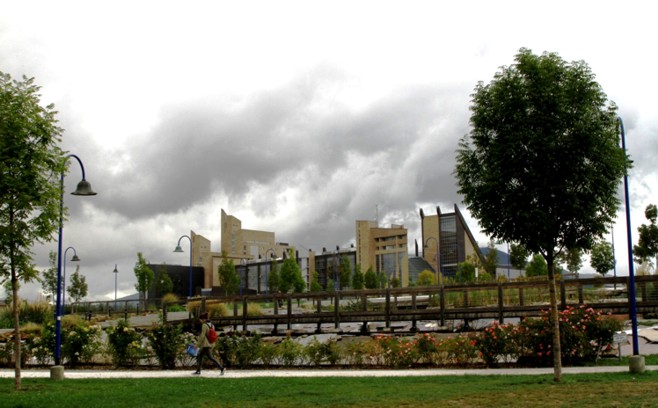
(Photo by Machiavelli_Aki)
A side note about Bongiorno’s arguments: in fact I had the feeling that allusion to implicit subtexts was something that belonged to her speech as a method or a style, it marked the whole of her arguments. You may recall Wittgenstein’s dictum “This work consists of two part, what is written in it, and what is not written in it. The latter is the most important part.”
Such a motto might be apt to address the major feature of Bongiorno’s defensive argument, insofar as she conveyed that something that “couldn’t be talked about openly” was there and that was probably a main argument.
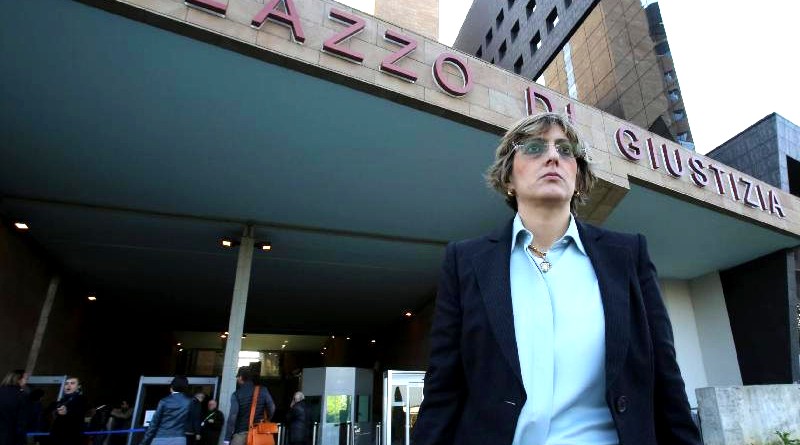
(photo by Ansa)
At first, as I said, she went through a brief emotional recollection of her moments while in Perugia surrounded by a raging mob, and then she unfolded the rest of her introductive section.
The purpose of this bit of revolutionary narrative first juxtaposing the Perugian citizens to Sanculots and the judges to Jacobins, and then, immediately following, a series of accessory arguments all encompassed by an introductive function, all this was clearly intended to set a framework thesis meant to work as a basis for the structure of the whole defensive arguments.
It is in fact a peculiar structure, apparently entirely resting upon one, single elaborate premise.
The thesis she places at the foundation of the entire defensive argumentation is the following: the trial as a whole, as much as its outcome, had been somehow determined and “tainted” from the beginning by events which occurred within a very short framework of time, in the very early days of the investigation, the weeks around the time of the suspects’ arrests.
Bongiorno suggested that only this “short period” ““ the early days of November 2007 - is what matters and the only topic worth of a defence analysis; since this was the time frame within which - according to Bongiorno - everything was decided, this was the time when some “errors” in the investigation occurred, before the point when a veil of prejudice and hatred fell upon people’s hearts and minds like kind of black curtain, preventing from that moment on any fair or rational judgement.
Aggressive Digressions
After the quoting of Satta’s speech, she develops her introduction for a while, branching out into some political-sociological speculations (such as that authorities chose the crime scenario that was most reassuring for the population) as well as some political-anthropological consideration (like the theory that free spirited women are seen as suspicious as a consequence of women empowerment movements).
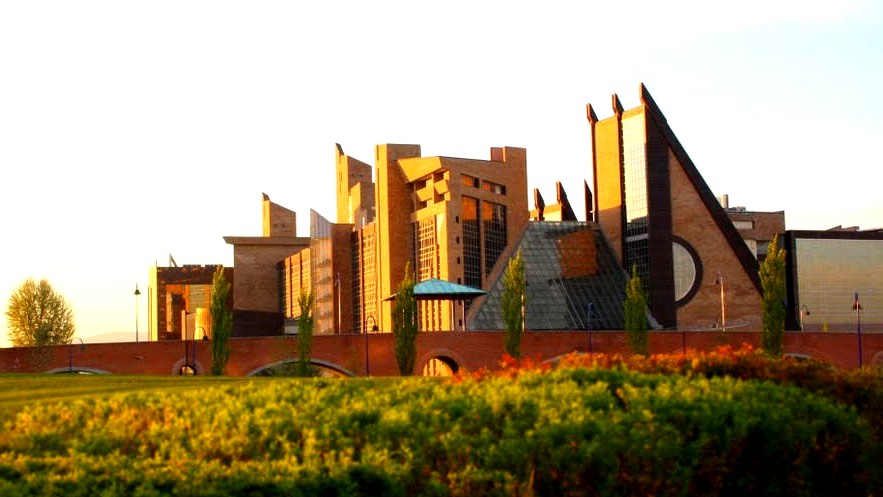
(Palace of Justice of Florence ““ photo by FrederickStudio)
A speech opening as did Bongiorno’s, that is, relying on a set of over-the-top considerations, and apparently so much depending upon one extreme premise, unavoidably conveys a perception of weakness, which is at risk to be transferred to the rest of the argumentation.
Thus, it would be a logical question to ask ourselves: why did Bongiorno chose such a setting and introduction, with several risky, over-shooting arguments?
A perception that the argument was unconvincing was palpable among the public as she was unfolding her theories about Perugian police opting for “political” scenarios and about sexy and free women seen as suspicious because of the women’s political movement.
Scepticism emerged even more openly when she described a scene with Amanda Knox releasing her false accusations while speaking under the hypnotic influence of interpreter Anna Donnino - whom she called “psychic” ““ which triggered some stifled laughs among the public.
Then her long introduction dealt with the unfolding of a rhetorical structure set around the concept of “half”.
I use the word ” rhetoric” in a most technical, non-derogatory sense, to mean the setting of a clear order and concepts designed to be easily remembered, anchored to multiple implicit suggestions, so as to remain impressed in the mind of listeners what is distinctive of the style of Giulia Bongiorno.
Introducing to “˜Halves’
In the previous trial instances she didn’t miss the opportunity to borrow characters such as Jessica Rabbit, Amelie and the Venus in a Fur. I thought she would mention at least a few characters of Disney or the Harry Potter saga this time too, and I was not disappointed as she met expectations on this matter (she did mention Harry Potter, the Eskimo kiss “˜Unca-Nunca’, the Bunga Bunga, the Aladdin Lamp and 9½ Weeks).
She entered the topical part of the introductive section saying “˜basta’ to always focusing on Amanda’s personality alone, while considering Raffaele just Knox’s other “half”, he is not half a character, he should not be seen as reflexion of Knox.
The curse of being “half” chases him also, meaning there are only “half pieces of evidence” against him. And this is the rhetoric structure envigorating the arguments after the introduction, the concept of “half” .
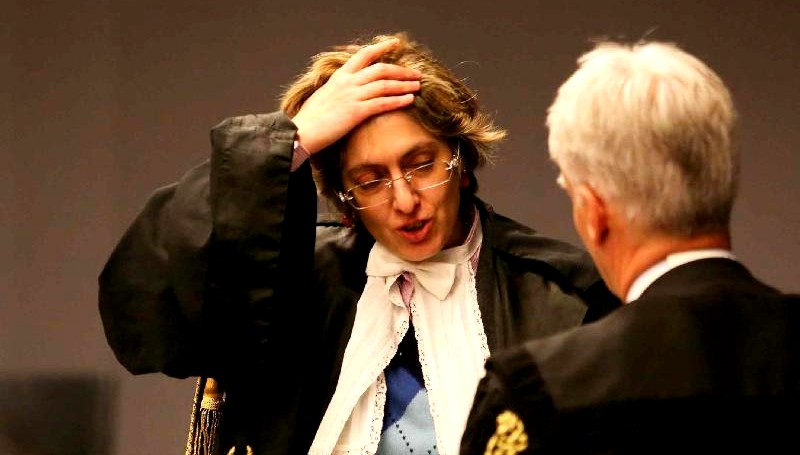
Only half pieces of evidence, almost a half admission, or the clear suggestion that there is maybe one “other half” of something (of culprits?) somewhere else, something not to be said, something that is not here.
The concept of “half” recurs and somehow pervades her defence, we should say something more about later on because she picked it up also in the subsequent hours of speech.
Some videos from the Florence trial available may still be available at the Sky site.
Primordial Fossils
Only after recollecting all these things in the “˜aggressive digressions’ over the introductive part, she goes on with a ponderous section which is the main part of her argumentation.
It’s a topic directly stemming from the introductive themes and premises, in the sense that this main part focuses on and blows up events of the first four days of investigation. It zeroes on few small details of the investigation history, the previous introductive part functionally working to justify the choice and to limit the argumentation to these topics.
Something the listener would notice from this first and main part of the arguments, as everyone well understands, is that these arguments are arranged in a peculiar type of architecture. A choice that makes crystal clear the actual state of the defence’s options.
The defence strategy is to focus attention on the supposed flaws in evidence collection at the beginning of the investigation, and not on the evidence set itself.
Bongiorno’s arguments do not map out the evidence set array. They do not devolve an effort of analysis in proportion to the actual weight of the of pieces of evidence.
The bulk of her speech in fact can be summarized as a criticism of some historical happenings ““ what she sees as such ““ which allegedly occurred within a very small time frame. She devoted hours to attacking the beginning of the investigation, early errors such as that the shoe print that had been wrongly attributed to Sollecito on a first assessment.
It appears this attack against the early procedures of the investigation was really considered to be the most effective weapon the defence had left.
The “˜topics’ Bongiorno addressed in this attack as “˜main points’ of evidence against Sollecito, are only three: the wrongly attribute shoeprint, Sollecito’s side-tracking the investigation, and “˜the knife’ (a topic which gets picked up again later, with a long discussion focused on the blade length).
In the same “˜knife’ topic she included DNA discussion, in a connected digression she dealt with the bra claps, called all the scientific evidence collection “˜the mother of mistakes’ and offered again the known criticism of Stefanoni’s alleged “suspect-centred”.
Later in her speech, she dealt with the other evidence topics, parroted the “˜principles’ expressed in the Conti & Vecchiotti report, offered the known arguments about the bathmat print, etc.
But the bulk of her defence hinged around those “˜mistakes’ in the early investigation phase, this was the actual core of her argumentation, while the other pieces of evidence were dealt with summarily, I had the impression they were almost treated as accessories.
It was clear above all that the defence was not battling the structure of the evidence actually existing today, they were battling a minuscule part of it, or better they were battling something else, something which is not directly the evidence, but rather some historical foundations of the accusation building.
Basically what Bongiorno conveyed is, the fighting terrain was the “˜investigators’ errors’, their “˜excesses’. That is, they were not actively contending Raffaele’s innocence any more.
The implicit content was rather obvious to the listener: a direct claim of Sollecito’s innocence had been already abandoned, that territory was left beyond the lines and the defensive front had been drawn back.
The topic now was not innocence, but rather how the accusation had been unfair and excessive.
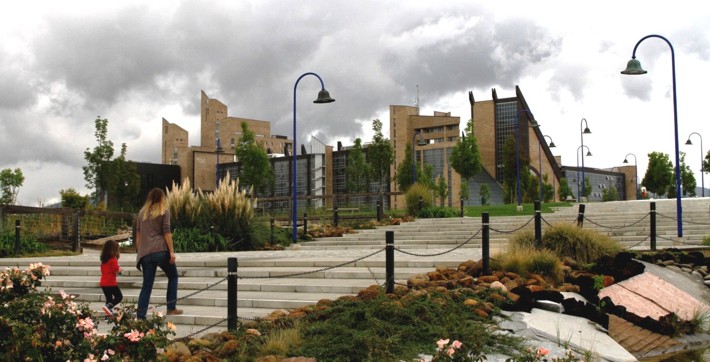
At her opening, the quote of Satta was a device to draw attention to the events at the “origin”, so as to prepare listeners for the fact that defence arguments will be focused on what happened during the moments before the “black curtain” came down.
Hence the a long introduction starting from an image of the fury of a mob of sanculots, a narrative on this theme: people were willing to convict the defendants immediately and judges were legitimizing people’s violence.
She oriented the discussion towards the topic of early prejudice and excesses, so to justify the fact that she will talk about the early phases rather than the evidence set, and then she introduced the leit-motiv of the “half”.
This means, rather than disputing the pieces of evidence, Bongiorno wanted to set a “trial of the investigation”, she zeroed on just a few details actually not having much relevance in the actual evidence set.
She talked at length about elements that are kind of fossils ““ like when she went on discussing about the number of circles in the sole of Guede’s shoeprint ““ putting the alleged “errors” in the course of the investigation on trial, and her speech at times sounded as if it was a lecture about dinosaurs, recalling curious things now extinct.
The explicit function of her introduction was to justify her setting aside the evidence set, downplaying it by framing it into a historical moment, maintaining that it was collected and interpreted when investigators were already beyond the “black curtain” of bias, therefore tainted by prejudice, while judges were like sycophants before an angry mob.
The purpose behind the Black Curtain
The implicit, most important function of the introduction was accomplished via the concept of “half” and all the subliminal suggestions attached.
We should ask ourselves: is it reasonable to believe Bongiorno was so naïve to expect that the court may accept a theory about a dismissal of evidence in limine?
The answer is no. Bongiorno knew perfectly well that her preliminary criticism of the investigation would not lead to a dismissal of the evidence.
Bongiorno also knew that the series of preliminary arguments she would offer would be considered ineffective by judges. Such as that the knife DNA should be seen as unreliable preliminarily, that Stefanoni’s work lacked “transparency”, that Vecchiotti and Conti’s “method” should be taken at face value (Bongiorno knows C&V’s intellectual honesty was called manifestly questionable by the Supreme Court ), that this and that allele in the bra clasp DNA should not be considered because, etc.
She also knows that this court will not allow pieces of evidence to be considered separately from each other in a parcelled out way, and that imperfection of single pieces themselves do not work as a logical argument. Even less could she dismiss the evidence based on political and anthropological theories.
From the fact that she was setting afoot on a trial of the investigation instead of battling the evidence, the rational listener infers that she is well aware of the weakness of her position, since it implies that the evidence set as the battleground would be indefensible. She needs to search for another terrain of attack, a different structure, as the only possible move.
But there is also another implication. She does need to engage and draw attention to areas where she could “win” something, but this also means that her intent was to “soften” the accusation, to work it out at the flanks rather than face it frontally; to reduce the size of some fundamentals, the “excess” of the accusation.
In other words, to shorten the sentence. And if possible, to separate Sollecito’s position from that of Amanda Knox, albeit within the boundaries of her client’s plea.
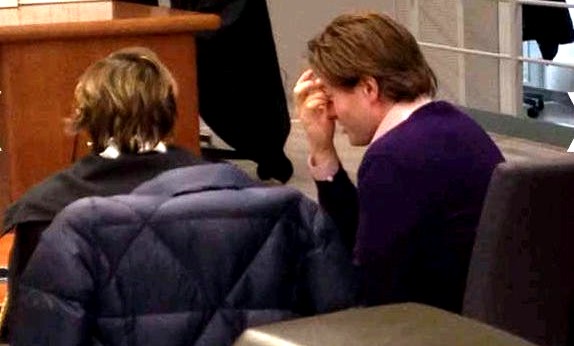
Her strategy of attack had a reason, that was to try to soften the accusatory attitude against Sollecito. Besides being risky (may sound extremely unconvincing) the strategy was also loaded with implicit meanings.
What was most stunning to me ““ as it was a recurrent topic through her whole speech ““ was the concept of “half”. She picked up this introductive theme several times, such as while speaking about the medical findings explaining that only “half” the length of the blade would be used, if a knife so large as Sollecito’s kitchen knife was used, saying that, in this event, this would mean the perpetrator did not intend to kill and killing was the effect of “mistake”, an involuntary movement.
The importance of the length of the big blade and its “half” was emphasized by a waving of knifes, in a quite impressive theatrical performance: “Either the big wound was made by a smaller knife” that was held by “someone else” or the knife was “plunged only by half” showing there was no intent to kill.
All this is to be coupled with the fact that, as said above, she devoted a main portion of her 6-hour speech to discussing things that are fossils, elements not existing any more.
She dealt later with other pieces of evidence too, though in a way that seemed somehow marginal, and she did not deal with some of them at all - the inconsistencies in Knox’s account, for example, were left completely out.
She was not that kind with Knox’s written memorials either, calling them “farneticanti” (waffling, raving).
I noted her complaining about Raffaele being “halved”, as his character is portrayed as depending on Amanda’s and thus seen as equally guilty insofar he was Amanda’s half ““ and this effect is somehow transferred to pieces of evidence.
Bongiorno’s rhetoric emphasizes that Sollecito was accused on “half” pieces of evidence (you perceive that the metaphorical repeating of “half” implies that evidence actually exists, “by half”, and at the same time this complaint about being seen as “half” of something is a subliminal suggestion that the defendants should be considered separately, and their charges as well, thus maybe their responsibilities if considered separately may be different; and when it comes to discussing how the murderer used only half of the blade, the subliminal suggestion is bring down the charge by half, involuntary event/manslaughter versus voluntary murder).
The Mark of Infamy
Giulia Bongiorno picked on the investigators and acted as if she was putting the investigation on trial not because she thought that this would lkead to the defendants being found innocent, but exactly for the opposite reason, because she expected them to be found guilty.
Insults against Prosecutor General Crini, against witnesses and and gratuitous accusations are a risky path but they are also an overt attempt to “soften” the investigation scenario, rather than fight it frontally.
She had no hope to make her client look innocent, her only hope was to soften the strength of the accusation, to make him look less guilty, not so bad as the investigators saw him.
She pursued this in two ways, by suggesting that he should not be seen as the “half” of another perp but rather his responsibility should be considered separately, only that evidence which proves directly against him (Bongiorno repeatedly pointed out that Knox did not utter his name in her interrogation and statement), his actual responsibility might be much lesser than the charge for which he is accused.
The other arm of the defence’s pincer move, the second way to try diminish the accusation, was to portray the investigators in bad light. The “˜excess’ of accusation was to lay blame on investigators for their bias and errors.
Bongiorno’s attack against the investigation might be intended to achieve a psychological effect due to comparative process.
If you consider how the police are responsible for “˜excesses’ and disputable behaviours, you may think the investigators have been prone to gross mistakes that lead to exaggerating Sollecito’s implication, thus the accusation should be not be taken at face value and should be corrected. Maybe the correct assessment of evidence proves he not as much implicated as they had thought.
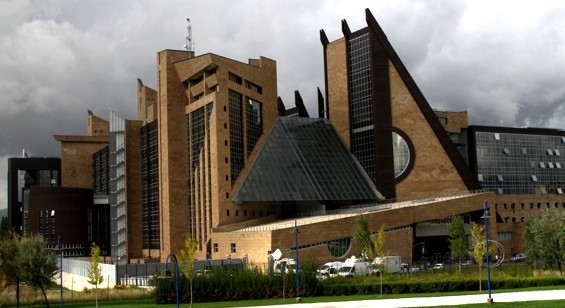
This seemed to be Sollecito’s own defence strategy, albeit implicit, since Bongiorno must restrain her action within the boundaries of her client’s plea.
In order to follow her strategy, however, Giulia Bongiorno decided to take a few steps which must be pointed out as particularly reprehensible and infamous.
I was surprised and stunned by those action because they qualify the character of Giulia Bongiorno as far worse than I thought, I really did not expect her to stoop so low.
The infamous part of Bongiorno’s speech is her gratuitous name calling and defamatory attack against Anna Donnino, her attempt to smear her professional reputation and the rude insult in calling her a “˜psychic’.
In real life Anna Donnino is a very respected professional, she has been working for the Questura on tasks of interpreter and language mediator (not as a “˜translator’).
She is also an intelligent person, she is precise and expresses herself with the utmost clarity as her lucid testimony shows.
She is known not only for having unquestionable professional ethics, but also she has an excellent reputation as a person; she is honest and humane and known by everybody for her extremely reassuring, protective temperament, and for her expertise and excellent performance of working with people.
She would help immigrants in difficulty to express themselves and understand their rights and was priceless helping the police to obtain precise information in their investigations.
As an expert in chuchotage and linguistic mediation from two foreign languages, the professional quality of her work is excellent. Her training and work is of interpreter and language mediator although sometimes shee is given translating tasks such as the translation of recordings and wiretappings.
The Questura of Perugia used to hire “˜language mediators’ at the time. You don’t know what a language mediator is? See a university course for a degree in Language Mediation.
The Questuras of some bigger cities also have “˜cultural mediators’ in addition. They are mother-tongue trained to deal with African or Chinese immigrants (one of the many young people having their internship as cultural mediator in a Questura is shown here.)
To me, this defamatory attack against Donnino was most disturbing. By doing this Bongiorno came across as surprisingly mean, I’d say what she did was really infamous.
Indeed this was not the only virulent attack, it came after insults to the city of Perugia as she was comparing its citizens to a mob of blood-thirsty fanatics.
This attack too is also particularly vicious, since it exploits, inflames and is subtly synergic with the tones of lies and prejudices disseminated by a perfidious propaganda strategy.
But at a certain point, Bongiorno focused the defamation against one person. As she unfolded a narrative about Anna Donnino acting as a “˜psychic’ who managed to hypnotize, to gaslight Knox to the point of inducing a state of trance in which she mistook a dream for reality, some people couldn’t help laughing in the courtroom.
But even if we consider the surreal and comical rather than the convincing effect, the defamatory intent stands out as reprehensible and humanly vicious.
This is because, as I said above, these particular insults were directed against a person distinguishable for her being a most decent, honest and trustworthy character, and also ““ a further reason ““ because of the recent events for which this person experienced personal suffering: Anna Donnino, a mother of teenagers, has been struck with cancer, and has undergone surgery.
She is under treatment but still currently remains in very bad health.
The attack against Anna Donnino is an action that rebounds as an ugly stain on the reputation of those who launched it. A young man from Perugia created a Facebook group to express a the citizens’ “hate” for those who lead a defamatory campaign of lies against the city. He collected over two thousand likes within three days.
Some of the comments were about Bongiorno’s insults against the city and against respected citizens, pointing out her outrageous hypocrisy since Giulia Bongiorno poses as a campaigner for the respect and dignity of women.
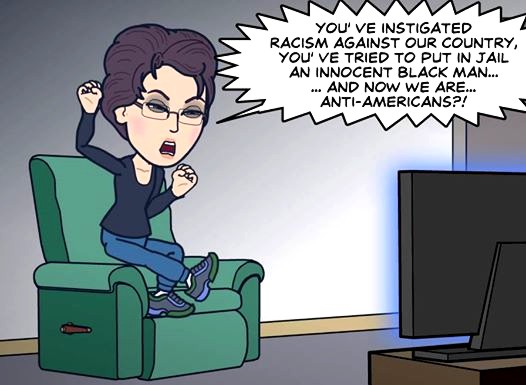
(a StripBit comment by a poster on a Facebook group)
Criticism of Giulia Bongriorno pointing out her hypocrisy is actually not a novelty, it has appeared long since in the press and on the internet.
But it’s hard to understand how someone like her, promoting an image of herself as an advocate for women and for correctness and respect in language and culture, could take such a an egregiously visible false step, come out with such stupid stereotypical rants, only for what looks like an awkward and useless cause.
Conclusion
A note for the record: we may recall Bongiorno has also attacked the Perugian police officers, citing the recording of some of their phone conversations in which they say bad words about the Sollecito family.
We can understand her outrage (at least we could, if only she were not the hypocrite she is) but at the same time we can’t fail to notice that she “forgot” to mention another half of the phone call recordings.
Specifically those where the members of the Sollecito family were speaking about the police officers; and the kind of language they were using, while attempting to plot “˜under the table’ help from some politician.
Expressing their intent to “˜scorch’ officers and “˜destroy’ magistrates, and one person even suggested that if he met Monica Napoleoni on the road, he would kill her by “˜running over her with the car’ then flee without telling anything, pretending that nothing happened.
Never mind.
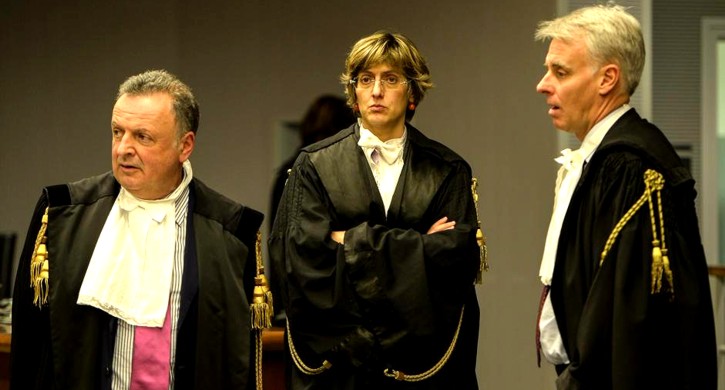
After these last sparkles and the knife waving Bongiorno’s performance was over. In the following day’s hearing it was Maori’s turn. As a really last resort, he was taking on the task of disputing evidence in a more “traditional” way, objecting to points of evidence.
Possibly this revealed even more the extreme weakness of the defensive argument (a commenter called it “˜pathetic’). I did not listen to his argument myself, I only notice that he did not get much space neither in the press nor in the pro-Knox commenting sites; this might be a clue of how unconvincing he might have been.
One thing that however I could learn about it, is about the feeling, the perception that Maori pointed out even more the separation between the two positions of Amanda Knox and Raffaele Sollecito.
A hint about this comes in the words of a journalist who was questioning Alessandro Nencini in the lounge immediately after the verdict: the journalist pointed out how Sollecito defence “tried to split the positions of the two accused”.
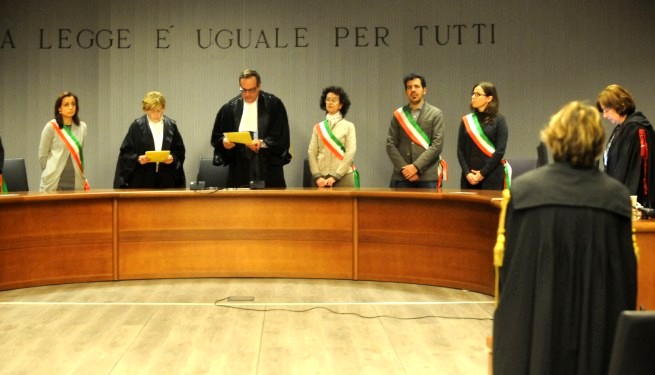
This mild attempt of a separation was the last act by the defence. As for Raffaele Sollecito himself, we were left with his rather different claim, his book where he described himself as sticking to a “˜honour bound’.
He reportedly bragged about this also with his ex-girlfriend Kelsey Kay, who described him as feeling very entitled because of his loyalty to Amanda Knox and believing she owes him a vital a favour; but Knox won’t even respond to his messages.
Then, we had his final admission in an interview that his friendship with Amanda Knox has “˜deteriorated’, because apparently Knox in practice no longer supports him as before.
If his defence advisors understood that they needed to somehow “˜separate’ his position from Knox’s at any cost, despite his plea, to suggest he may be implicated but just “˜less’ guilty, we may only agree with them on this. It would also be convenient for him to confess even if he shared the same degree of guilt of Knox.
Sadly, instead he still felt compelled to offer further lies and changing stories such as”˜I noticed no blood on the bathmat’ when questioned by Kate Couric; he offered again a story of pricking Meredith’s hand while cooking together at the cottage.
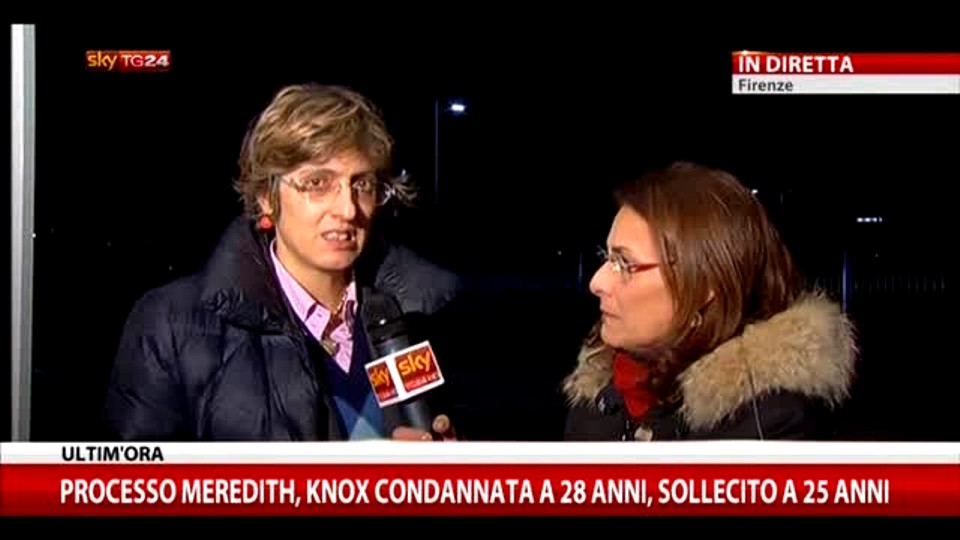
Other murderers, who committed even more heinous crimes, have recovered and rehabilitated themselves after time spent in prison; even some of those deemed among the worst serial killers managed to do this by expressing remorse ““ for example the rather psychopathic “˜Ludwig’ (Furlan & Abel) killers.
Sure after the years he will spend in jail for the gang-like crime he is found guilty of, there would be a possibility for a “˜casual murderer’ such as he is to be perceived as rehabilitated. But to see him as “˜less guilty’ or as “˜rehabilitated’ would be impossible as long as he remains silent or denies.
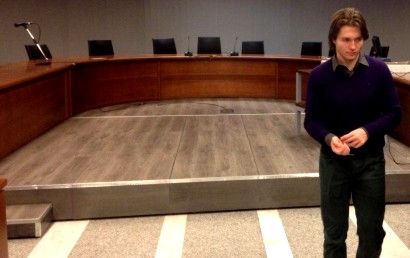
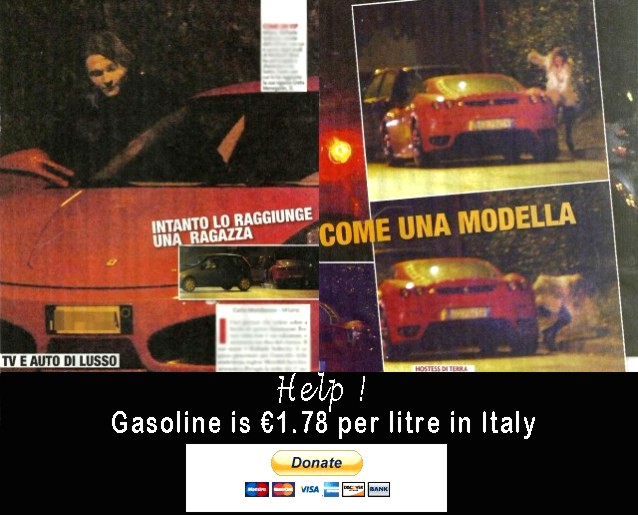
Wednesday, February 26, 2014
How Claims By Perpetrators & Their PR That THEY Are Victims Get Equal Pushback
Posted by Peter Quennell
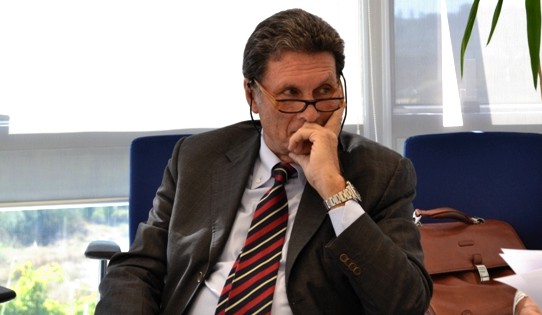
[Florence prosecutor Giambartolomei will soon confront many false claims ]
To the considerable pain of victims and their loved ones, Italy’s has become one of the most pro-defendant justice and penal systems in the world.
That doesn’t mean that it has become a complete pussycat. Push it, and it usually pushes back harder in its search for the truth. And the quality Italian media goes along.
Time and again the ill-conceived short-term PR and legal tactics for Knox and Sollecito based on a hurricane of lies have left them in terms of the ultimate end-game worse off than they were before.
Judge Matteini and Judge Micheli (the judges in 2008) both took firm lines with the copious evidence and the psychological tests of AK and RS in front of them.
Both judges took a line as firm as the prosecution (as firm as the “evil Mignini”) in concluding that there was a drug-fueled hazing escalating to murder with sexual aspects (however short the timescale of the intent).
[Ed note: See comment by Yummi below which explains the above a little differently. PQ.]
Though his panel of judges voted unanimously for guilt, Judge Massei in 2009 did take a somewhat less firm line in the sentences, after observing one daffy defendant and one very nervous defendant sitting in front of him for nearly a year. Judge Massei for no especially convincing reason
(1) pinned the initiating of the attack on Rudy Guede (really?!) and
(2) handed Knox and Sollecito (and thus Guede) quite a break with his supposed “mitigating circumstances” (the duvet over Meredith’s body) resulting in 20 years lopped off their combined sentences.
Both the defenses and the PR were weak and largely futile in that year. But come 2010 the dirty tricks moved into overdrive.
Cassation reverted to the firmer line in January 2011 when it ruled on Guede’s final appeal: Guede was a party to the murder, but copious evidence proved he did not act alone.
The Hellmann appeal court and DNA consultancy and verdict of 2011 were corrupted (counter-measures are still quietly playing out) which fully explains its startling soft line.
Thereafter the Italian courts observed the illegal blood-money binge with the essentially fictional books of Sollecito and Knox, and two years of them each claiming to ill-prepared interviewers “we’re the real victims” on TV.
Cassation observed all of this, annulled the corrupted Hellmann court verdict, and issued instructions in June 2013 to the Florence appeal court to ensure that the firm line should be maintained. Unsurprisingly, we have seen a firm line from the chief prosecutor (Crini) and a seeming firm line from the lead judge (Nencini) in recent weeks.
In the rest of this year Italy will see at minimum these events where the court’s firm line will go on and the babbling and unhelpful legal and PR tactics may finally dry up.
- 1) RS and AK continuing to babble for a while on TV as they each dig the other one deeper. Sollecito has just said that his saliva or sneezing may explain why his DNA was on the clasp of the bra.
2) The sentencing report of Judge Nencini is due at the latest on 30 April and he seems likely to give space to rebuttals of any bizarre new claims made by Knox and Sollecito before 30 April like the one just above.
3) The obstruction of justice trials of witness Luciano Aviello and incessant meddlers Mario Spezi and Frank Sforza will continue, probably though into 2015. Each of those trials could result in others (like Spezi ally Doug Preston and Sforza allies Bruce Fischer and Steve Moore) being declared at minimum persons of interest if not actually charged.
4) Florence prosecutor Giambartolomei Firenze (image above) may soon be announcing which passages in Sollecito’s book Honor Bound criminally defame Italian officials or deliberately miscontrue hard facts in evidence in an illegal attempt to to poison public opinion against the court.
5) Similarly soon after on Amanda Knox’s book with the surreal title Waiting To Be Heard (and on Knox articles and interviews in Oggi) by the chief prosecutor in Bergamo.
6) Cassation’s First Chambers should be the one to handle Knox’s and Sollecito’s final appeal. They handle murder cases and they issued the guidance to Florence in 2010.
7) If so, they should take note of such revelations by way of Judge Nencini’s and Prosecutor Crini’s reports; and this next autumn or winter may finally declare a firm “confirmed guilty” final-appeal outcome and invite Knox to come back.
And when prosecutor Giambartolomei Firenze announces which claims are radiocative, hopefully a major hush will come over Heavey, Fischer, Bremner and Moore.
Monday, February 24, 2014
Power Shift In Italy Very Unfavorable To Anyone So Stupid As To Thumb Their Noses At Italian Justice
Posted by Peter Quennell
Meet 39-year-old Matteo Renzi
Mr Renzi was sworn in by the President of the Italian Republic on Saturday as the new Prime Minister of Italy. As a top German newssite remarks, he is looking like a much-needed breath of fresh air.
Mr Renzi is colorful and dynamic and very popular, and may become one of the most effective leaders in recent Italian history and a major player on the world stage. Mr Renzi comes from FLORENCE where he was the popular and effective mayor.
Unlike the Berlusconi faction in parliament (which once included Giulia Bongiorno) Mr Renzi is a big friend of law and order, police, and justice. In the image at bottom you can see him opening the huge Palace of Justice in Florence with all the top officers of the court who just organized the appeal.
This is very bad news for Sollecito and Knox and their foolish gangs, as Mr Renzi will be very unlikely to look kindly on that same Florence court - and any court in Italy including, especially, Cassation - being flouted by convicted perps and made to look weak.
If the new Minister of Justice sends an extradition request to his desk, you can bet that he’ll send it on to the United States. And the US, very keen to stay on good terms with Italy as one of its 2-3 most reliable allies, will exhibit little if any resistance to the extradition of Knox.
More bad news for Sollecito and Knox
The sardonic Italian media is paying very close attention to the ongoing game of each of them pushing the other closer to the flames, and the almost-certain prospect of the two of them and Rudy Guede explosively flying apart.
The Italian media is picking up on signs that Sollecito has become highly resentful at his on-again off-again rejection by Knox, especially as many or most in Italy believe it was Knox who wielded the big knife that killed Meredith to which the other two had maybe not signed on in advance.
There are additional pressures headed down the pike. First, Rudy Guede will be given brief study leaves soon, and under Italy’s new “clear the over-crowded prisons (somewhat)” law Guede could even soon see himself released and free to talk.
Plus the investigators examining the criminal defamation of the justice system and officers of the court by Knox and Sollecito in their exceptionally foolish books are believed very close to announcing that a case against them has been made.
Sollecito’s father on national TV has already admitted that Raffaele lied about a deal to get him off, and this on Knox seems an open & shut case. Knox and Sollecito might face additional sentences of 3 to 7 years if they keep provoking a hard line.
Here are two articles translated by Miriam which summarise (not perfectly in our terms but good enough) the signs of the growing divide and the evidence that will see Knox and Sollecito back in prison.
Amanda Knox Will Return to Italy and Go to Jail, as Will Raffaele Sollecito, While Rudy Guede Will Be Freed
This scenario is not only plausible, but seems to be the natural outcome of the last sentencing of the Mez case. Few believe that the Corte di Cassazione could overturn, again, the verdict of the Corte d’Assise d’Appello of Florence.
So Amanda Knox will return to Italy and go to jail. For Amanda Knox, “her extradition is quite possible” Christopher Blakesely say without equivocation. He is one of the main experts on such penal proceeding in the United States.
The day after the verdict of the Corte d’Assise d’Appello of Florence, Giovanna Botteri, the RAI correspondent in the USA, reported something similar, underlining that Amanda rushed to CNN to cry all her tears didnt help.
Knox uses even the social networks to scream again her innocence, but the law says something different.
Even Italian popular opinion seems not in Amanda’s favor : Perugia, through the social networks, has literally screamed its disagreement and displeasure against Amanda (read: L’Urlo di Perugia: a Facebook page against Knox: from the people of Perugia)....
Rudy is at the moment the only one sentenced in jail…. How does Rudy reconstruct that night? Rudy swears to having consensual sex with Mez.
After the intimate relation Guede went to the bathroom and from there he heard her scream, rushing to her room he found her in a pool of blood, and tried to help her. Realizing that Meredith was dead, in shock he ran away.
On the plausibility of this reconstruction, the judges had numerous doubts, to the point of finding Guede guilty and sentencing him.
This reconstruction, according to his lawyers, explains not only the biological traces of Rudy all over the crime scene but also his flight.
How does Amanda reconstruct that night?
Amanda continues to sustain that she did not wield the knife that killed Mez, that she heard her scream while she was in the kitchen and that she covered her ears like a scared child.
The “whys” are many and heavy. Why did Amanda accused Patrick Lumumba, incarcerated for 14 days while innocent, due to her ignominious accusations? Why on the knife used for the murder are there traces of Mez and Amanda?
Knox DNA was on the handle of the knife that killed Meredith: only because she used it to cut potatoes? The alibi of the potato has always been used by Knox and her lawyers, but it is plausible?
And Raffaele Sollecito?
One of the most decisive evidence against Sollecito in the first trial was the bloody foot print on the bathroom math. In the appeal process that footprint was challenged, it was said that it could be not Sollecito’s and was ascribed to Guede with benefit of doubt .
Now it seems certain that Rudy was wearing shoes ,as is demonstrated by other prints at the scene of the crime, thus the bloody footprint goes back to being ascribed to Sollecito.
Why is Rudy Guede in jail while Amanda and Raffaele are on the loose?
After the verdict of the Corte d’Assise d’Appello of Florence the appeal to the Cassazione, was announced, while waiting for the Cassazione, the guilty Raffaele Sollecito had to hand over his passport in order to make it impossible for him to leave Italy.
Right after the sentence Sollecito was stopped in Udine about 60km from the Italy/Austrian border and about 40km from the Slovenian border.
Before the verdict of Corte D’Assise d’Appello of Florence Sollecito was a free man, and therefore legally in possession of a passport and the right to cross the border.
Sollecito, instead of waiting for the verdict in the court room, around 12 o’clock that day left with his new girlfriend and arrived in Udine [in north-east Ital]..
Around night time during a snow storm the two of them took refuge in an hotel , and the owner recognizing Sollecito by name, alerted the police that promptly arrived in order to confiscate Sollecito’s passport as decided by the Court.
Sollecito told the media that he had no intention of fleeing the Country.
One can ask what Sollecito was doing in Udine then, a few hours after his guilty verdict. To excuse Sollecito one can perhaps say that the young man was overpowered by anguish and fear, in fact up to today
Sollecito had never seemed to want to evade justice, instead he was usually in the Courtroom.
Amanda in contrast was not sanctioned with any precautionary measures. She arrived in America as a free citizen after the not guilty verdict.
Now, if and when the Cassazione confirms the verdict of the last proceeding, America needs to extradite Amanda and remit her in the hands of the Italian Justice…
America is tied to Italy by sanction accords by name of international laws, thus if the Cassazione upholds the guilty verdict, Amanda must return to Italy. Nothing makes one think that America could oppose an extradition.
Rudy Guede is the only guilty one in jail at the moment. His detention was confirmed after a fast track trial, decided by his layers, and his detention was 16 years in jail. (with time off for the fast track trial)
Not many know that while the doors of the prison may soon open for Amanda and Raffaele,, for Rudy instead “freedom” may be close by.
Thanks to the new decree passed last December by the Parliament, Rudy could leave the prison where he is detained. Guede is one of 3 thousand detainees who could benefit from the “empty the prisons” decree.
Raffaele Sollecito and Amanda Knox are close to a break up after the sentencing..
Raffaele wrote Amanda a letter saying: “Amanda I am tired. I don’t want to be punished, neither do I want to continue to give justifications for matters that concern you and not me”.
Amanda says “I understand him but: I want to say that Raffaele is not my slave and I am not his oppressor. Raffaele has many reasons to be resentful, but not with me.”
The bond between the two, accused of the homicide of Meredith Kercher, is cracking. A bond that lasted from that horrible night of November1st 2007, when in a house in Perugia, via della Pergola, their English friend was savagely killed.
Looking at a concrete possibility that the Judges of the Cassazione will confirm the sentencing which condemned Amanda and Raffaele to 28 years of jail for her and 26 for him, the two ex-lovers are starting to distance themselves from each other.
Amanda took a picture of herself holding a sign that read “we are innocent” so as to underline a common faith, from which Raffaele can’t dissociate. Not anymore.
Raffaele after six years may be starting to understand that being Amanda’s “fiancé” did not help him at all. He said this to Giulio, in an interview a few months ago, and now in an interview to CNN:
In the Judges head I must be guilty because I was Amanda’s boy-friend. It does not make any sense for me. According to the Judges because in some way I supported Amanda, I must be implicated. According to me this is aberrant. My standing has not been just ignored, but completely forgotten. In all the proceedings I was not part of them unless for the scientific investigations.
For many, many hearings the topic was my DNA, but nobody said nothing of the reason why I was accused of the homicide except the fact that I was Amanda’s boy-friend and because I was with her very often and spent many nights with her, I had to be in some way connected with the homicide.
Is Raffaele’s defense thinking of ditching the girl? Is Raffaele ready to tell the truth of what happened that night? Now Raffaele is in Bari, and is thinking over what happened to him. He reveals:
I discussed with my friends and family the possibility of going abroad a year ago, but I cannot accept the fact of leaving all the people who are dear to me for a theory. I had no motive to hurt Meredith Kercher.
Now I have no light in my future. They took away my passport and I.D. card, and I do not know if I can realize my dreams, or anything I want to do. I do not accept that my future is destroyed.
Too often, though, Amanda and Raffaele forget to mention that Meredith’s life really was destroyed.
Against Amanda and Raffaele there are scientific evidence, bloody footprints on the floor, DNA on the bra clasp and knife, and the many contradictions in their alibis.
From the beginning their behavior caused the carabinieri to be suspicious of them.
Without forgetting the spontaneous confession of Amanda of being in the house while her friend was being murdered. “I have a vision of being in the kitchen, covering my ears while they kill her.” She even gave the name of the killer Patrick Lumumba, her boss, who was then discovered to be innocent.
The attempt to divert the investigation, pointing the finger against an innocent man, is evidence of the quilt of Amanda.
Even Raffaele changed versions more than once. In one of the interrogations he said Amanda was not with him that night and arrived at his apartment in the early hours of the morning. He then said he smoked too much marijuana and could not recall what happened that night.
In the meantime Rudy Guede, 27 years old, condemned to 16 years for the murder of Meredith Kercher, with others, writes:
Now that my verdict is definite, for too long the judicial reasoning have been subjected to a continuous and willful manipulation and alteration of the data of the proceedings… I would like to point out that I do not accept being labeled as a homeless man, drifter, and a thief; when instead I had a splendid family and precious and clean friendships in Perugia.
Amanda Knox’s defense team wants to pass him off as a habitual thief. Rudy adds: ” “Meredith’s house was turned upside down, someone simulated a break in. I was not condemned for this simulated break-in.”
If it was not Rudy, then who?
Tuesday, February 04, 2014
Defense Dirty Tricks: Did We Just See Yet Another One, An Attempt To Compromise Judge Nencini?
Posted by Jools
Judge Nencini offers corrections
This is my translation of a statement from Judge Necini carried by the Florence GoNews website.
“In relation to the press articles that reported my statements on the trial for the death of Meredith Kercher I intend to point out that there has been no interview organized or pre-arranged.
I ran into some journalists in the corridors of the courthouse who told me of the rumors and speculations that were being circulated on the duration of the deliberation session.
I then had a brief talk with them meant, in my intention, to clarify possible misunderstandings. In this I accept responsibility, reaffirming that I did not agree to disclose in any way the reasons for the sentence. In particular, I have not expressed any opinion on the strategy procedure followed by the defence of the accused.
In fact the only reference to that matter, reported in the article that appeared in Il Messaggero, is one in which I stated that the accused were defended in the process to a ‘very high standard.’
If my words have generated misunderstandings on this point and on the absolute legality of the choice of an accused to make spontaneous statements I regret it.
These explanations are dutybound for the respect I owe to the people who participated in the process with me and to the [Law] System of which I’m proud to be a part of; as well as for consistency in my professional history, with over thirty years of work carried out without spotlights and without interviews.”
Context for those corrections
This is in relation to the previous days articles claiming Judge Nencini supposedly gave an “inappropriate” interview to the press.
In very short order three or four lay members of the Superior Council of Magistrates (CSM) laid a complaint about non-appropriate conduct (under Art. 6 of the CSM rules) for a presiding appeal court judge to give press interviews commenting on the motivations reached by the judges on any sentence before its official publication.
Not surprisingly, the first people to complain were Bongiorno and Maori (grasping at straws, much?!!) and then to follow were these three or four lay members of the CSM, who happen to be also members of the centre-right political party “Forza Italia” (Berlusconi’s party).
As a result of the complaint made by these people, the Justice Minister, Annamaria Cancelleri, ordered an inquest on the allegations against Judge Nencini which could have led to his reprimand for disclosing details of the verdict reached to the press.
Personally, I think this all results from the desperation of Sollelcito’s defense and they have erncourgaed the others to instigate it. Making a meal out of nothing, in the hope that the whole appeal trial gets thrown out.
And let’s face it, it wouldn’t be difficult for Bongiorno to find some of Berlusconi’s people that are always looking for ways to attack members of the judiciary given Berlusconi’s hatred for the system. Just my opinion…
In any case, the allegations seem to be false, Judge Nencini actually didn’t say much, and the inquest will prove it, but in the meantime the press is concentrating on this rather than the hopeless work the defense produced. This maybe is the whole objective.
The later, longer interview
The interview by Fiorenza Sarzanini with Judge Nencini the following morning is claimed to be quite legal, because the decision of the court had been published the previous evening.
Andre Vogt kindly posted a very accurate translation on The Freelance Desk, and as it will scroll down soon and be hard to find, we can repost the full interview here.
Posted 1 February
Italy’s most influential newspaper, the Corriere Della Sera, this morning has published a fascinating long interview with Judge Alessandro Nencini about his reasons for convicting Amanda Knox. The interview was done by one of the newspaper’s most veteran crime and investigative reporters, Fiorenza Sarzanini. Click here to read the original.
HEADLINE: Amanda and Raffaele: The Judge Speaks
SUBHEAD: “I have children too; it was a huge burden.”
SUBHEAD2: “The defense had asked to separate the positions of the two accused, but Raffaele would not allow himself to be questioned.”
By Fiorenza Sarzanini
“I feel relieved because the moment of the decision is the most difficult. I have children too, and handing down convictions of 25 and 28 years for two young people is a very hard thing, emotionally.”
It is 10 am the day after the verdict and Justice Alessandro Nencini is in his office. The President of the Florentine Court of Appeals, which two days ago found Amanda Knox and Raffaele Sollecito guilty of the murder of Meredith Kercher, knows that the decision will “open up new debate, especially in the media”, but that is exactly why he agreed to explain how the verdict was reached.
You deliberated in chambers for 12 hours. Was the judicial panel divided?
“The case files took up half of the room. There are 30 expert reports. The lay judges, who aren’t court staff, had to read all the documentation to reach a joint decision, as is expected in the appeals court. You have to review all the documents, think about them, and reason. We did that using all the time that was necessary, and taking into account the fact that the victim was also a young girl.
And then the decision was unanimous?
“I spoke of a joint decision. I can say that in all these months and in particular during the last session of deliberations, we carefully considered the gravity of a verdict that involves young people and their entire families. This is a case that has consumed many lives.”
Yours was a narrow path, the Court of Cassation had urged you to remedy the Perugia appeal decision that had acquitted the two accused.
“Not so, we had maximum flexibility. The only restriction was that in the case of acquittal, we would have to have give reasons based on logic. There was no other binding restriction.”
Not even with regard to the decision handed down in Rudy Guede’s case?
“Effectively the specifics of the case was this: there was a person already convicted via fast-track, and definitively, for concourse in the same homicide. The Court of Cassation was asking us to consider who participated and their roles. We could have said that the two accused weren’t there, and then provided convincing reasoning, but we did not believe this to be the truth.”
Why didn’t you question Guede?
“For what purpose? He has never confessed and even if we had called him, he had the right to remain silent. We didn’t think it was necessary. Rather, we felt it was important to study the other aspects more in depth. In fact we requested an expert report and heard witnesses about which there were doubts. That is the role of the appeal judges. In four months, we’ve been able to arrive at a result.”
Sollecito’s lawyers had asked you to split the defence.
“We’ll explain the point more in the reasonings, where we will explain why we rejected that request. In any case, Sollecito did not want to be questioned during the trial.”And this influenced your choice to convict him?
“It is the defendant’s right, but certainly it removes a voice from the trial proceedings. He limited himself to making spontaneous declarations, saying only what he wanted to say, without being cross examined.”
Over the years, various motives have been speculated. What idea did you yourselves form?
“We convicted and we will explain it explicitly in our reasoning. For now, I can say that up until 20:15 of that evening, these young people all had different plans, then their commitments fell through and the occasion for this to happen was created. If Amanda had gone to work, we probably wouldn’t be here.”
Are you saying that the murder was just a coincidence?
“I’m saying this was something that unfolded between these young people. There may have been coincidences, and we’ve taken it into the reasoning. I’m aware this will be the most debatable part.”
Cassation demolished the acquittal. Will you as well?
“We are not going to mention it. We simply have to focus on the decision in the first instance (Massei) which we confirmed, on the facts.
And you don’t believe that there were errors?
“I didn’t say that. Some I believe there may have been and I’ll point them out.”
You convicted Amanda Knox, but didn’t issue any precautionary measures against her. Why?
“She is legally in the United States. At the moment of the offence she was in Italy to study and she went home after having been acquitted. She is an American citizen. The problem will arise when it is time to carry out the sentence. For now I don’t believe that such a measure wouuld have been necessary.”
So why then have you confiscated Raffaele Sollecito’s passport?
“It was the agreed minimum. In these cases such measures serve as prevention. We want to avoid that he makes himself impossible to find during the period of waiting for a definitive judgment.”
And you believe being forbidden to leave the country is enough?
“Yes, that seemed more than sufficient to us. If there are other developments later, we will consider them.”
Monday, February 03, 2014
Authors Of “Math On Trial” Bring The Explanations Of The Hard DNA Evidence Up To Date
Posted by Peter Quennell
The important new book in question Math On Trial is by mathematicians Leila Schneps and Coralie Colmez who is Leila’s daughter.
This article by Leila Schneps appeared in yesterday’s edition of The Independent and explains why the Nencini court has not ruled out any of the DNA evidence.
It’s not right to say there is “˜no evidence’ in the case against Amanda Knox. There’s plenty
The DNA alone is enough to raise questions
The verdict handed down yesterday at the new appeal trial for Amanda Knox and her former Italian boyfriend, Raffaele Sollecito, accused of the murder of British citizen Meredith Kercher in Italy in November 2007, may come as a surprise to those whose view of the case has been affected by an international media blitz based on the oft-repeated claim “There is no evidence”. Many believe that Rudy Guede, convicted in October 2008 for participating in the murder, acted alone.
There is, however, copious evidence to consider: the DNA alone is enough to raise questions. Leaving aside much of it, let’s focus for a moment on three key pieces of DNA evidence and present them from both sides, just as the jury may have heard them spoken of in court.First ““ the bra clasp.
The part of the victim’s bra containing the hooks had been ripped or slashed from the rest of her bra. Not immediately collected on that first day after the murder, it remained in the room in a sealed house for six weeks before being sent to the lab in December. There, it was tested and found to contain a large sample of Meredith’s DNA, together with a smaller but clearly visible contribution from Sollecito. The defence objections: firstly, between the two searches, objects in the crime room had been moved around, and indeed the bra clasp was found about a metre away from its original position.
Secondly, apart from “˜alleles’ - genetic traces - of Meredith and Sollecito on the clasp, there were a few unidentifiable extra ones. Putting these two facts together, the defence pointed out that Sollecito’s DNA on the bra clasp could have been a consequence of a careless police technician stepping on Sollecito’s DNA elsewhere in the flat and then entering the room and stepping on the bra clasp, even though no DNA of Sollecito was found anywhere else in the house except on a single cigarette butt in the ashtray.
Second ““ the mixed stain.
Although not visible to the naked eye, the chemical Luminol which flashes blue on contact with blood revealed a spot in the room of the flatmate whose window had been smashed and room rifled. Swabbing the spot produced a mixture of Amanda and Meredith’s DNA. This is a clear proof that the murderer entered that bedroom after the murder, as someone must have brought Meredith’s blood into the room, contradicting the defence theory that Rudy Guede broke into the house and then committed the murder.
The usual defence explanation for mixed DNA stains in the bathroom and corridor, namely that the house would have been coated in Amanda’s DNA given that she lived there, does not necessarily apply to a flatmate’s bedroom. It is much harder to leave traces of DNA than is commonly conceived, and hardly any of Amanda’s DNA was found in her own room - where she surely spent a lot more time than in her flatmate’s.
Lastly ““ the knife.
Days after the murder, a large kitchen knife was seized in Raffaele’s flat, where Meredith had never set foot. Police geneticist, Patrizia Stefanoni, swabbed spots on the blade of the knife and on the handle in the knife’s first DNA Test. One spot in particular attracted her attention: a visible scratch on the flat of the blade. The swab taken from this scratch yielded a positive ID for Meredith Kercher.
By the third trial, when a new attempt was made to collect DNA from the knife (which had been swabbed again during the appeal trial, though no tests were then conducted) there was no match to Meredith ““ a result welcomed by Knox’s defence team, though it did not in fact impact on the findings of the first trial.
Stefanoni’s test ““ she only conducted the first - came under strong fire in the courtroom. Two independent expert witnesses called in for the appeal against Knox and Sollecito’s original 2009 conviction stated that she had not worked in conformity with standard international protocol. Indeed, standard protocol for DNA testing involves three steps: first determining how much DNA is in a sample, secondly amplification, which reproduces the sample millions of times, and thirdly electrophoresis which produces the familiar DNA graphs showing peaks in the location of an individual’s alleles. Under cross-examination, Stefanoni explained that quantification had given a result of “too low” as the machine she used that day was not the most sensitive one in the lab.
Knowing that samples undetectable by the machine can still be sufficient to yield positive results, she chose to continue with testing. At the second stage of testing, amplification, a sample will normally be split into two or more pieces in order to run independent tests. But knowing that the sample was small, Stefanoni feared that cutting it in two would yield no result at all, and chose to amplify the entire sample in one unrepeatable test. The end result was a perfect match to Meredith Kercher.
Knox’s supporters have claimed since the beginning that the accusations levied against her are based on the Italian justice system’s hatred of a pretty, American girl who likes parties and having sex. And whilst both parties protest their innocence , Thursday’s decision shows that there is real evidence against her and Sollecito, that cannot be ignored.
Guide For Smart Media: Note Extensive Hard Evidence In Exceptionally Fair, Careful Legal Process
Posted by Media Watcher
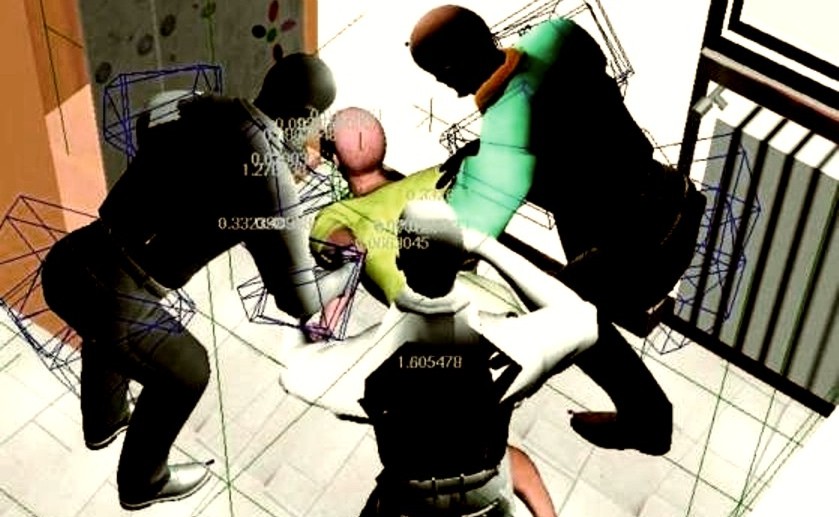
[Accurate Italian media recreation of attack based on masses of closed court evidence 2009]
Vital media history in 2009
In Italy and Europe generally the guilt of the two is almost universally perceived.
One reason is that although about 1/4 of the trial in 2009 was behind closed doors (quite the opposite of the “tabloid storm” and “show trial” Americans have been told about) Italians in particular got to find out about the long (15 minutes), remorseless, highly sadistic attack on Meredith.
Please click here for more
Friday, January 31, 2014
Appeal Session #10 Images: The Attorney General Of Tuscany Dr Tindari Baglione Breaks The News
Posted by Our Main Posters
This help with translation happened right after Judge Nencini finished reading the verdict and sentences yesterday
Below: images of Lyle and Stephanie earlier in the long tense day
Appeal Session #10 Images: The Two Judges And Six Lay Judges Deliver The Guilty Verdict
Posted by Our Main Posters
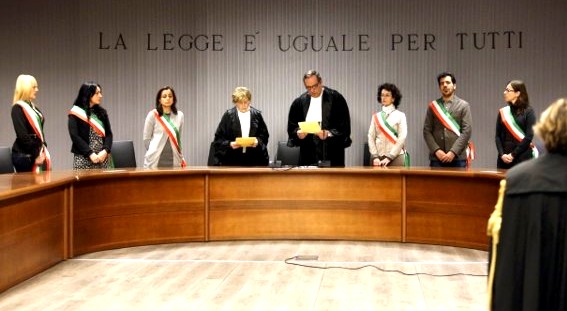
The statement is sharp and quite brief. Judge Nencini confirms that both Knox and Sollecito are confirmed guilty. The 2009 Massei verdict is upheld.
The sentences are 25 years in priosn for Raffaele Sollecito and 28.6 years in rpison for Amanda Knox including the 3.8 years for the calunnia already served. Each must also incur financial penalties.
Both may be locked in the sex offenders wings as both were confirmed convicted with a sex-crime component. Both may face further charges for false accusations of crimes in their books and in the media, as may some of their more strident “supporters”.
Few in the US and UK seem to realize, but the evidence presented at trial in the first half of 2009 was in fact overwhelming. In the US and UK it is probable no appeal would even have been allowed, as the appeal grounds were so flimsy.
Nothing was undermined at the Florence appeal. In fact the evidence became STRONGER as another trace of Knox was found on the big knife. Innuendo about DNA contamination was sharply rejected in face of zero evidence or even scenario.
Please read our case overview here which links to some vital posts and touches on several of the defense’s illegal tricks.
That includes the corrupting of the 2011 appeal, which is well understood in Italy but not registering with most US and UK media - Sndrea Vogt has begun reporting on part of it, the illegal meddling with the Hellmann DNA consultancy
..
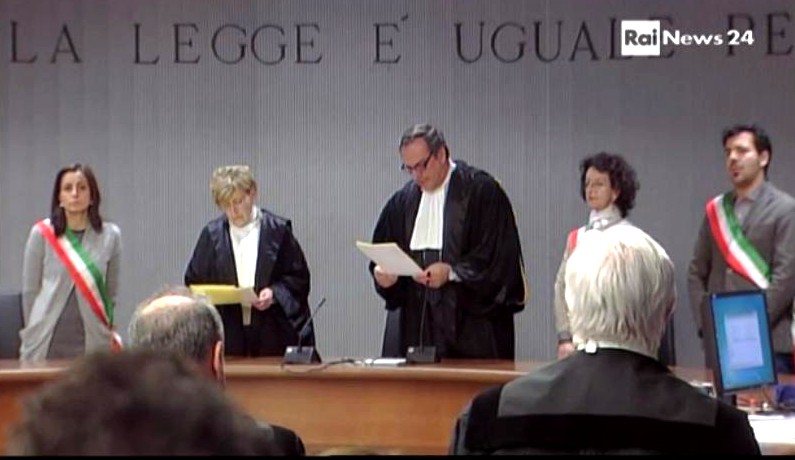
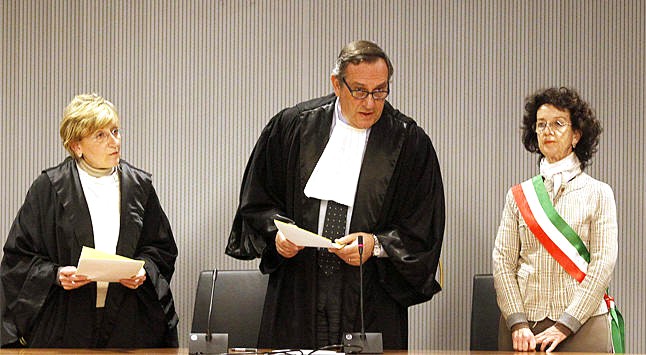
Thursday, January 30, 2014
Appeal Session #10: After Defense Remarks Panel Of Judges Reaches Its Decision: BOTH GUILTY
Posted by Our Main Posters
Verdict: Both are confirmed guilty
The Massei verdict is upheld. The sentences are 25 years for Raffaerle Sollecito and 28.6 years for Amanda Knox. Sollecito is to have his passport taken away.
For Knox they could issue a worldwide Interpol Red Notice for immediate arrest around the world, even before going for extradition, to stop her dishonest self-serving blabberings.
Take a look at our conjectures down the bottom of this post on the judges’ deliberations. Looks like we got One, Two and Four right and Knox will be named in the judges report as the prime instigator.
That will hardly help her resist extradition. And it will please Guede and Sollecito, who both always hint at that.
To CNN: yet again this is NOT double jeopardy. Read the extradition treaty. It was ONE valid trial (2009) and now ONE valid and failed appeal (2014). Not two trials.
Tweets from our main poster Machiavelli
26. All these many thanks are so warming and comforting; I’m glad my contribution was useful among the many others.
25. No measure taken for expatriation of Knox because she is a US citizen currently in her own country.
24. Passport withdrawn for Sollecito and movement restriction within the boundaries of the state of Italy. No restriction for Knox.
23. Ruled that Knox’s royalties belong to Lumumba,
22. Accessory penalties/settlements: established Knox stinks, ordered Dalla Vedova to change jobs… (!)
21. Her calunnia sentencing has been increased from 3 years (Hellmann-Zanetti) to 3 years and 6 months.
20. To be more precise: Knox has been sentenced to 28 years and 6 months. (She has already served four years).
19. Massei sentence confirmed (25y), Knox sentence increased to 28 years because of calunnia aggravation
18. Bongiorno very agitated
17. Five minutes and a half from a verdict?
16. Judge declared the verdict will be 3D and distributed goggles [?]
15. Sollecito was in the courtroom. Appeared nervous.
14. Said because of the greatness of their power they should acknowledge reasonable doubt.
13. Ghirga emphasized discretional power of the court. Said they have big power to acquit.
12. In point of law: Ghirga said evidence must be considered as a whole in compliance with SC, but assessment should find reasonable doubt
11. Said no blood on knife because of negative TMB and blood confirmatory tests.
10. Ghirga: cited the claims about picograms, said amount is not the point, the problem is test repetition and other conditions
9. Says bruise at back of head is compatible with frotal fight against single aggerssor (disagreement with Introna on this too)
8. Ghirga: Meredith’s blue sweater was removed before fatal stabbing, as for Torre’s opinion. Admitas he disagrees with Sollecito’s defence.
7. Ghirga talked about: Meredith’s blue sweater, an echimosis at back of her head, DNA laboratories and Stefanoni’s quantization
6. Ghirga recalled a small number of details of physical evidence and autopsy.
5. Dalla Vedova asked acquittal, did not specify, whereas Ghirga instead, talking later, invoked reasonable doubt.
4. D.V. says believes there are other Supreme Court rulings in his favor.
3. D.V. emphasized the single pieces of evidence should be assessed each one in parceled out, atomized way before considering the whole
2. DV focused on evidence assessment procedure, quoted SC rulings.
1. Dalla Vedova’s talking lasted a short time, and not very orderly.
Tweets from reporter Barbie Latza Nadeau
28. Court: Amanda Knox Is Guilty. See more in The Daily Beast.
27. Kercher family members being briefed by lawyers and British consulate.
26. Sollecito must surrender all documents, passports, identification,
25. Its 25 years for sollecito and 28.6 years for amanda knox
24. Amanda Knox [2009] guilty verdict upheld, sollecito [2009] guilty verdict upheld.
23. Judges and jury enter.22. Huge security presence ahead of verdict including riot police outside and in public area of courtroom amandaknox tense
21. meredithkercher sister stephany and brother lyle have arrived in court for verdict.
20 Prosecutor Crini has arrived in court for verdict in amandaknox appeal
19. Clerk says between 9-930 local time judges will return. Says judges want “utter silence no shouting or clapping”
18. Court clerk says verdict will be delivered between 9 and 9:30 tonight.
17. Amanda Knox “˜Afraid’ Of Today’s Court Verdict http://thebea.st/LeteHD via @thedailybeast
16. Court clerk says at 8pm she will go back to judge to find out if and when they are ready to deliver verdict.
15. Court clerk says “presumably verdict at 8:00 but everyone come back at 7:00
15. Court clerk just announced that at 6pm local they will tell us when the verdict will be announced.
14. Mario Spezi, author of Monster of Florence, has come to court to hear amandaknox verdict.
13. Lawyers for amandaknox and sollecito, journalists already in courtroom ready for verdict that come come any time from 5pm Florence time.
12. Lunch has just been brought in to judges and lay jury deliberating amandaknox case. No wine.
11. Refreshments just delivered to jury members in amandaknox new appeal, espresso, cappucino and possibly a tea…
10. Judge in amandaknox new appeal says decision will not come before 5pm.
9. amandaknox lawyer asks court to absolve his client.
8. amandaknox lawyer says the dna on the knife attributed to meredithkercher can not be verified, can not be considered.
7. amandaknox lawyer Ghirga tells court they have to look at all the evidence to reach verdict, not value pieces here and there.
6. amandaknox lawyer says you can’t put two innocent people in jail to cover up mistakes of judicial system.
5. amandaknox lawyer tells judge: you cannot convict for murder in the name of Italy when evidence is ‘probably’ attributed to a defendant.
4. amandaknox lawyer says you can’t cancel out evidence, says Amanda’s rights were violated, she was in shock when she accused Lumumba.
3. sollecito in court by his dad who said they are all nervous for verdict over drinks with journalists at hotel bar last night.
2. amandaknox lawyer CDV says they are serene going into verdict because they believe in her innocence,
1. Court in session. One of the jurors wearing a shiny spangled skirt, rest dressed soberly.
Tweets from Freelance Reporter Andrea Vogt
13. Meredith Kercher’s brother: It was the best we could have hoped for, but amanda knox verdict not cause for celebration.
12. amanda knox guilty verdict upheld. Her lawyer Carlo Dalla Vedova said he has called her. She did not cry. She was “petrified.”
11. amanda knox conviction upheld. sentenced to 28 years and six months. Sollecito to 25. Ordered passports to be taken.
10. Meredith’s sister and brother are accompanied by British consulate officials. A hush has come over the courtroom.
9. The family of meredith kercher has arrived in court to hear the verdict.
8. Even most experienced Italian court reporters not predicting what long wait for amanda knox verdict means. Could go either way
7. amanda knox verdict is expected at 9 or 9:30. Clerk reminds about the decorum expected:no applause, shouting, cheering, etc
6. Standing room only in Florence court as media, legal teams, public await amandaknox verdict (timing soon to be announced).
5. Judge and jury in amandaknox case have retreated for deliberations. Verdict not before 5 pm Italy time.
4. amandaknox Judge : we will not give a verdict before 17, after that,can come any time, but will announce with lots of advance notice.
3. Ghirga: We wait anxiously and seriously for justice for Meredith. But doing justice means doing it also for amandaknox and RS.
2. amandaknox lawyers are in court. Ghirga: “siamo fiduciosi, serene, emotionati.” (Roughly: “Trusting, calm, on edge”).
1. Verdict expected late today in amandaknox appeal….
Freelance Reporter Andrea Vogt On Website
From The Freelance Desk
Amanda Knox is expected to wait out the verdict in her appeal at her mother’s Seattle home (likely with American television news networks present) while Raffaele Sollecito was in court with his father and a friend. Sollecito made no remarks upon leaving for the courthouse in a taxi, surrounded by a pack of cameras. Meredith Kercher’s sister, Stephanie, and brother, Lyle, are also expected in Florence today for the court’s decision, expected in the evening hours….
Conjectures on what the judges may be discussing
The panel of judges is in effect deciding now on positions that must be sustained in 2-3 months in a 100-400 page document that must be okayed by the Supreme Court.
This might be what the quite long (by Italian standards, they will have discussed the case intermittently) jury discussion today is focused upon. Here are four possible issues.
Possible issue one
As sharp Italian media are pointing out, Prosecutor Crini departed from the Massei scenario and suggested a different driver in one key respect.
Like Mignini and Micheli in 2008 he assigned the role of prime mover to Amanda Knox and not to Guede. (Nobody ever assigned it to Sollecito.)
Maybe hoping to give RS and AK a break the Massei jury (not neccessarily the judge himself) assigned to Guede the primary role in starting the attack, saying maybe he forced himself upon her.
Then maybe the other two came in from next door, and set about helping him to subdue Meredith.
They just happened to have two knives handy, and even Massei assigns the fatal blow to Knox.
Crini argued as more likely that Knox started to quarrel with Meredith over hygiene or drugs or money and the other two joined in and for 15 minutes the attack escalated.
In this Knox and not Guede is assigned the role of prime mover.
The judges may want to accept this and seek to assign Knox a harsher punishment accordingly.
(Neither court seems to have settled on a convincing reason for why the big knife was brought down from Sollecito’s house which looks to us at minimum forboding.)
Possible issue two
This relates to the scenario in the comment above. Judge Massei lopped five years off the routine sentences by conjuring up “mitigating factors”.
One such factor was the duvet placed over Meredith which Massei thought could be a sign of remorse, surely by a woman.
Many including psychologists never agreed with this. It could have been simply an aversion to all the blood, which Knox on the stand in 2009 chillingly described as “yucky”.
If so the sentences awarded could creep up beyond the durations decided on by Massei. Above 25 and 26 years.
Possible issue three
This is an alternative to One and Two above. The judges might think the crime was more like a manslaughter, an attack that ended in murder
But not intended as such and never agreed to by two of the attackers. In which case sentences could be a lot lighter.
Possible issue four
There are financial award considerations. How much to award to whom, plus maybe ways to ensure their payment in light of Knox blatantly stiffing Patrick..
[Below: image of the judges and lay judges arriving this morning]
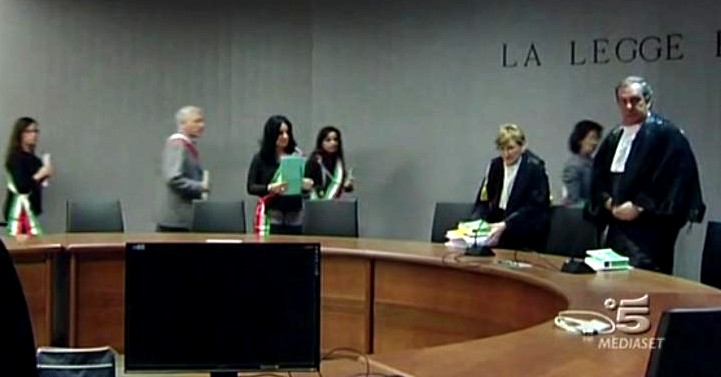
Wednesday, January 29, 2014
Continuing Enormous Strength Of The Evidence Which Defenses Seem To Have Abysmally Failed To Shake
Posted by Our Main Posters
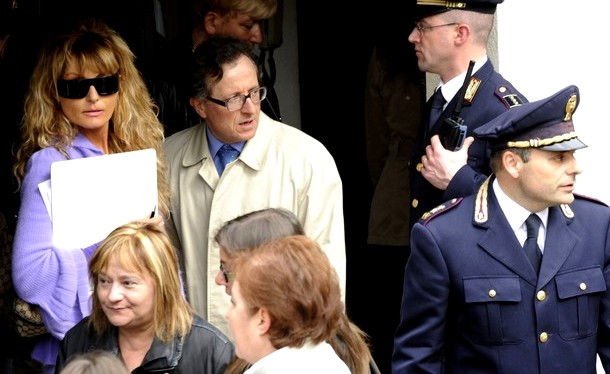
[Above Judge Massei at Meredith’s house with panel-of-judges members early 2009]
What this Florence appeal is REALLY about
There is much confusion on this, sowed by various at-distance commentators who don’t read the Italian press or the excellent English-language reporters right there on the spot.
This is NOT a re-trial. This is a FIRST appeal by Sollecito and Knox against the guilty verdicts and sentences Judge Massei awarded them late in 2009. It is being repeated since their defense teams helped to bend the first (Hellmann court) iteration of the first appeal two years ago.
Since the end of 2009 they have been provisionally guilty of murder and other crimes, subject to final ratification by the Supreme Court, which has not yet occurred. Judge Hellmann decided to let them out and travel worldwide. Many think his decision on this was legally weak.
Was there prime-face justification for this appeal?
Under US and UK law many lawyers and judges think the judicial process could have stopped right there in the US and UK, because the grounds for appeal the defenses came up with in 2010 were essentially innuendo about DNA and little else.
But the pro-defendant Italian system unlike almost any other in the world allows appeals if any are filed to automatically go forward. So the bent, stretched-out and illegally wide-scope Hellmann appeal of 2011 was the first result.
Appointed apparently in illegal circumstances to replace the highly-qualified Judge Chiari (the lead-judge for criminal appeals, who then resigned) Judge Hellmann was ill-qualified at best - he was not a criminal judge and had handled only one other murder trial before, which he got wrong.
The annulment of the first first-appeal
The Supreme Court very rarely completely annuls any trial or appeal. But in this case in March 2013 it did just that, on a large number of grounds.
The 2013-2014 Nencini appeal court in Florence starts with the early-2010 Massei report plus new guidelines from the Supreme Court. Nothing else floated since early 2010 counts.
This case seems to break all records ever for (1) defamatory and dishonest PR; (2) dirty tricks, many illegal, by the defense; (3) dishonesty by those accused in two defamatory books and multiple statements to the press; and (4) greed and blood money while the process still goes on.
Contempt of court trials and investigations have commenced to push back, Amanda Knox is particularly at risk because her book contains false accusations of crimes (again) and she defies the Supreme Court in not paying Mr Lumumba his damages though she destroyed his business.
Suggested Reading: Part One
Sooner or later (no necessarily now) read all the must-read posts in this group here, all the open questions for Sollecito in this group here, and all the open questions for Amanda Knox in this group here.
1. Getting up to speed on the 2008 RS and AK charges
Our four-part summary of Judge Micheli’s report is the best thing to read (scroll down) especially Micheli’s argument that ONLY Knox had any reason to re-arrange the crime scene - she lived there and needed to point evidence away from herself.
Also read Amanda Knox’s and Raffaele Sollecito’s many mutually contradictory attempts to provide one alibi for both.
2. Getting up to speed on the 2009 RS and AK trial
The prosecution performed brilliantly and left the defenses despondent and out-classed (paving the way for more dirty tricks in 2010-13) and we were told that two defense lawyers nearly walked off.
To get a flavor of how badly the defenses did, read this post and this post on Knox’s absolutely disastrous stint on the stand. From there the defense portion of the trial really went downhill.
To get a flavor of how well the prosecution did read about the damning reconstruction (known about in all of Italy but not widely elsewhere) described here and here.
3. Getting up to speed on the Massei 2010 Report
The most vital read of all is the short-form version of the Massei Report by Skeptical Bystander and a team on PMF dot Org. If you have no time to read any posts, make sure to read that.
The other vital reads, not here but on the new “The Murder Of Meredith Kercher Wiki”, are the overview of the evidence and the chart of evidence synopsis.
We had a large number of posts starting in 2010 checking out whether in all details the Massei Report got it right. Read this first take.
4. Getting up to speed on the crime-scene scenario
Vital to understanding the Massei court’s crime-scene scenario which Prosecutor Crini espouses, wade through this excellent reconstruction of the crime in a long Powerpoint by our lawyer James Raper with the Powerpoint whizz Kermit.
About Part Two
The next part of our most-recommended reading from 2010 to 2014 will follow after the verdict to help correct the ill-informed debate over whether Knox goes back to jail.
It hardens the case and in our view leaves no holes for RS and AK to wiggle through. We will point the post to those arguments that anyone tries to raise.


